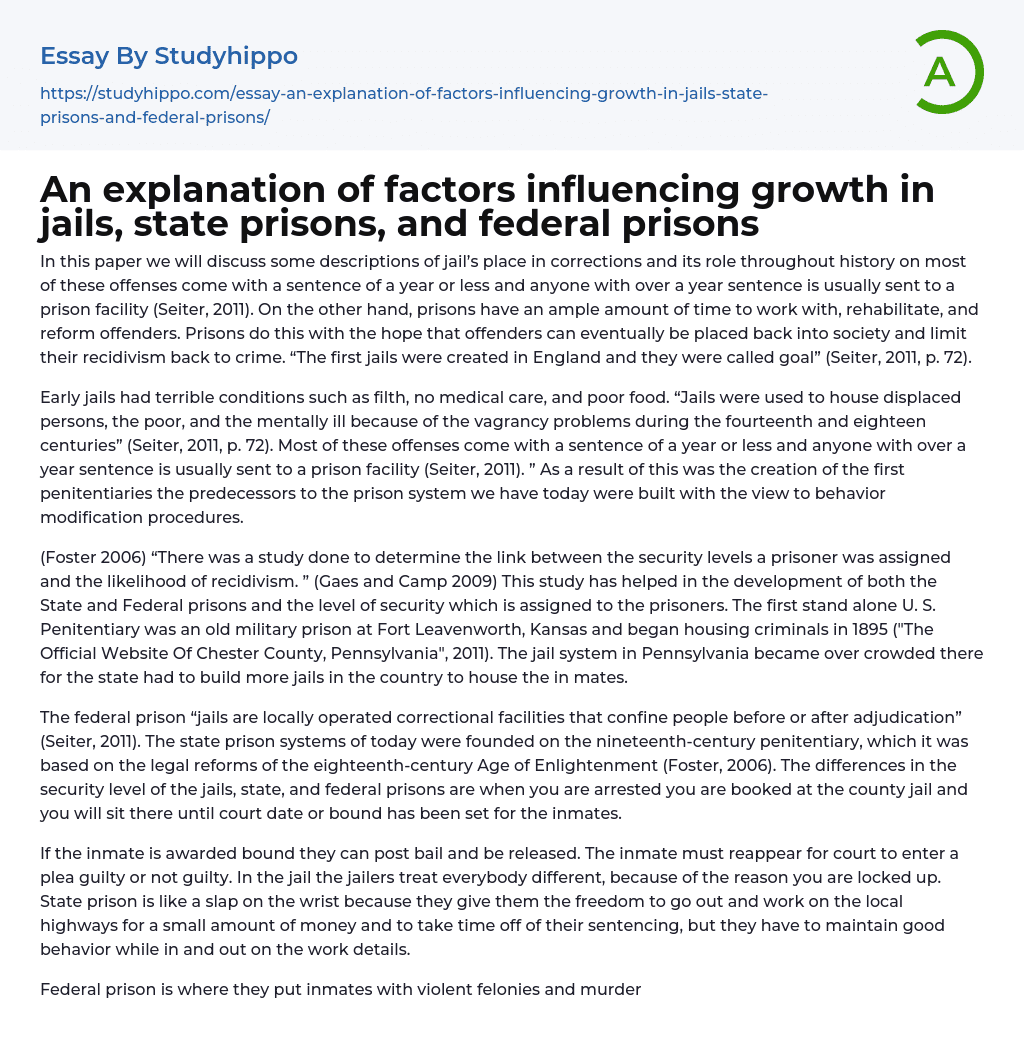

Jail’s Place in Corrections and its Role Throughout History
In this paper we will discuss some descriptions of jail’s place in corrections and its role throughout history on most of these offenses come with a sentence of a year or less and anyone with over a year sentence is usually sent to a prison facility (Seiter, 2011). On the other hand, prisons have an ample amount of time to work with, rehabilitate, and reform offenders. Prisons do this with the hope that offenders can eventually be placed back into society and limit their recidivism back to crime. “The first jails were created in England and they were called goal” (Seiter, 2011, p. 72).
Early jails had terrible conditions such as filth, no medical care, and poor food. “Jails were used to house displaced persons, the poor, and the mentally ill because of
...the vagrancy problems during the fourteenth and eighteen centuries” (Seiter, 2011, p. 72). Most of these offenses come with a sentence of a year or less and anyone with over a year sentence is usually sent to a prison facility (Seiter, 2011). ” As a result of this was the creation of the first penitentiaries the predecessors to the prison system we have today were built with the view to behavior modification procedures.
(Foster 2006) “There was a study done to determine the link between the security levels a prisoner was assigned and the likelihood of recidivism. ” (Gaes and Camp 2009) This study has helped in the development of both the State and Federal prisons and the level of security which is assigned to the prisoners. The first stand alone U. S. Penitentiary was an old military
prison at Fort Leavenworth, Kansas and began housing criminals in 1895 ("The Official Website Of Chester County, Pennsylvania", 2011). The jail system in Pennsylvania became over crowded there for the state had to build more jails in the country to house the in mates.
The federal prison “jails are locally operated correctional facilities that confine people before or after adjudication” (Seiter, 2011). The state prison systems of today were founded on the nineteenth-century penitentiary, which it was based on the legal reforms of the eighteenth-century Age of Enlightenment (Foster, 2006). The differences in the security level of the jails, state, and federal prisons are when you are arrested you are booked at the county jail and you will sit there until court date or bound has been set for the inmates.
If the inmate is awarded bound they can post bail and be released. The inmate must reappear for court to enter a plea guilty or not guilty. In the jail the jailers treat everybody different, because of the reason you are locked up. State prison is like a slap on the wrist because they give them the freedom to go out and work on the local highways for a small amount of money and to take time off of their sentencing, but they have to maintain good behavior while in and out on the work details.
Federal prison is where they put inmates with violent felonies and murder, drugs, and arm robberies with a gun. There is a program set up for the inmates whom didn’t finish High school and want to receive a GED or take up a trade while
in prison they give them the option to do so and be successful when they are released back out into the real world to start a new life. A lot of security officers treat the inmates as if the inmates are their own family member and some of the officers are just there for a pay check.
American prison system began with the Walnut Street Jail in Philadelphia, which served as the first prototype for the Pennsylvania model for prisons where prisoners worked at tasks in solitary confinement in order to pay off their debt to society and theoretically reflect upon what they had done (Johnston, 2010). “Jails are locally operated correctional facilities that confine people before or after adjudication” (Seiter, 2011).
The jails growth is large because the youth are raising themselves and the only way they is the streets and then the youth are lead down the wrong path and end up in jail for all kinds of crimes. So it starts with our young people and the system is set up where as once in system always in system being moved from one jail. Once a person has been jailed or incarcerated, they are categorized by most employers as third class citizens, which limit their opportunities to climb out of a cycle of poverty years after their release.
- Commitment essays
- Feminism essays
- Animal Rights essays
- Animal Testing essays
- Bullying essays
- Abortion essays
- Abuse essays
- Immigration essays
- Poverty essays
- Human Rights essays
- Inequality essays
- Violence essays
- Torture essays
- Crash essays
- Assault essays
- Racism essays
- Prejudice essays
- Controversial Issue essays
- Cyber Bullying essays
- Women's Suffrage essays
- Women'S Rights essays
- Women Empowerment essays
- Sojourner Truth essays
- Bullying In Schools essays
- Pro Choice essays
- Pro Life essays
- Should Abortion Be Legal essays
- Against abortion essays
- Abortion Debate essays
- Abuse Support essays
- Child Abuse essays
- Alcohol Abuse essays
- Physical Abuse essays
- Sexual Abuse essays
- Substance Abuse essays
- Migration essays
- Human Migration essays
- Illegal Immigration essays
- Immigrants essays
- Refugee essays
- Overpopulation essays
- Homelessness essays
- Hunger essays
- Dumpster Diving essays
- Homelessness In America essays
- Euthanasia essays
- Assisted Suicide essays
- Censorship essays
- Gun Control essays
- Empowerment essays



